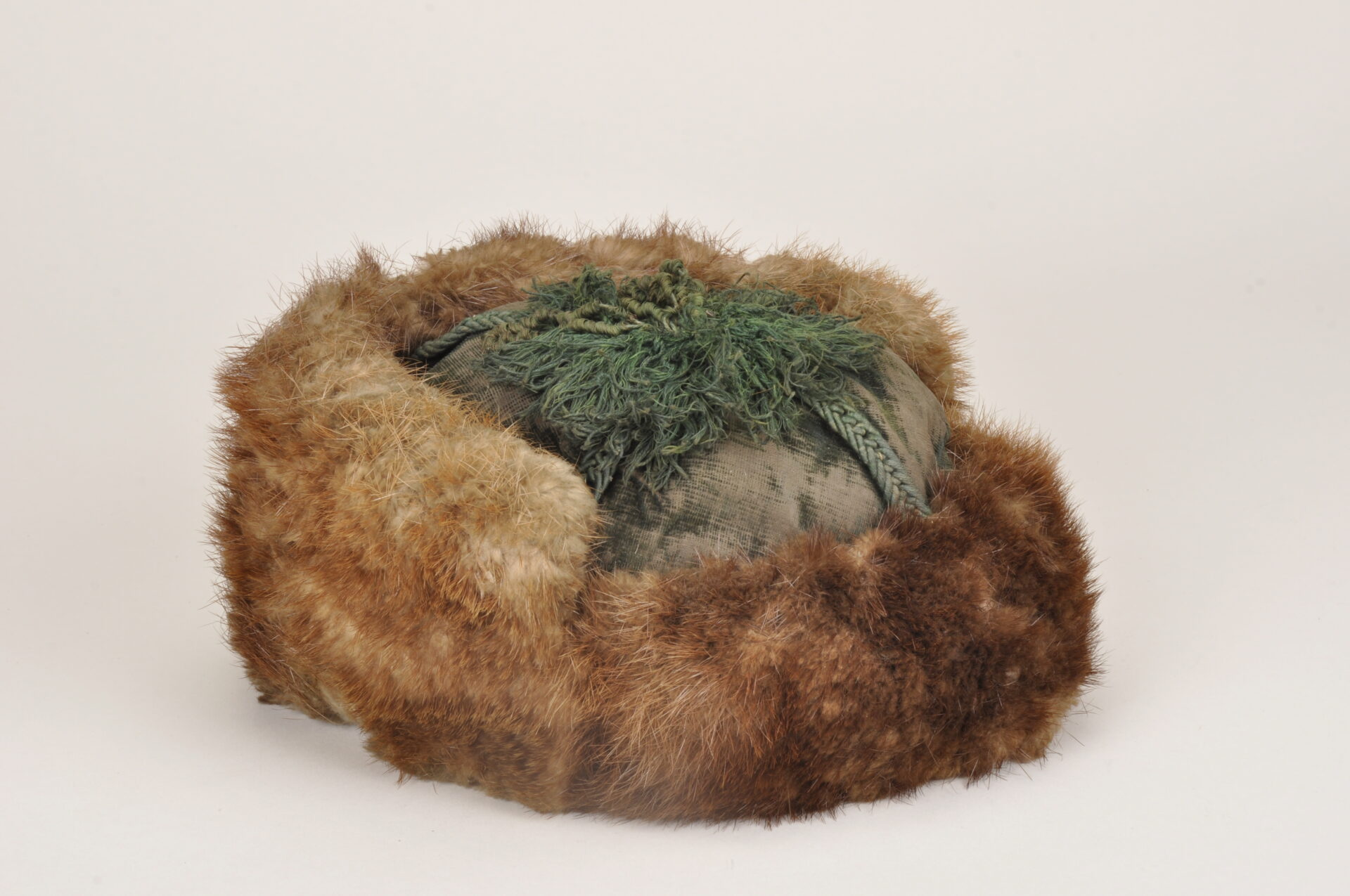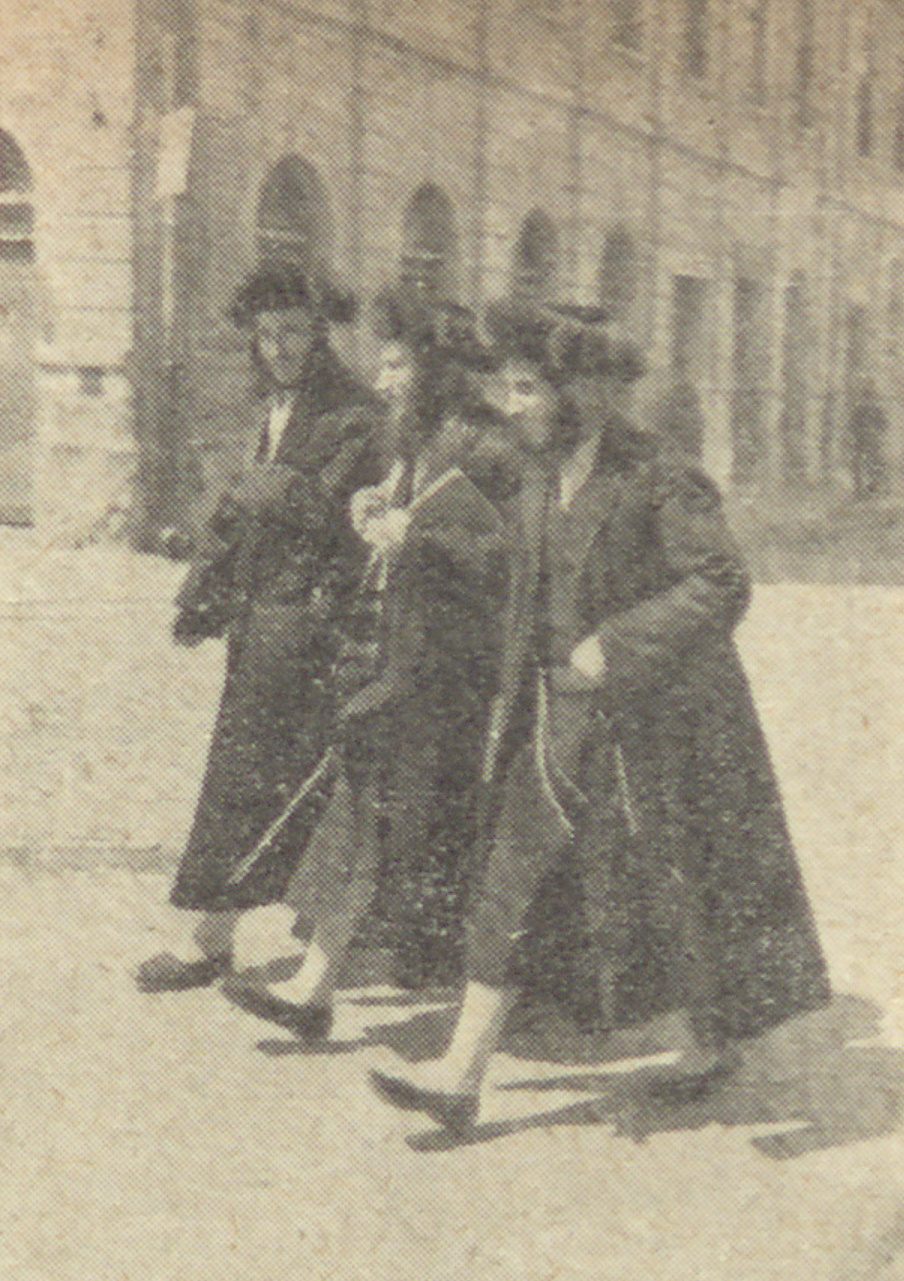Biberhit vagy cilinder?
„A kalap pénzbe került. A háború előtti képeken jól látszik, végignézve Magyarországon mindenki azzal fedte be a fejét, amivel tudta. Régen nem lehetett kalap alapján megkülönböztetni kalap alapján az egyes csoportokat, ennek anyagi okai voltak. A haszid világ egyértelműen a borbélykalapot hordta, minden lengyel rebbe is ezt hordta. Középkori eredetű. A haszidok nem hoztak öltözködési újításokat, a selyemkaftánnak az volt az oka, hogy abban biztos nincs együtt len és gyapjú. A színes kaftánokat az egyéb rebbék hordták. Hétköznaponként azt hordtak, amit tudtak. Nagyvárosokban követték a divatot a 20. századtól. Pl. sábeszkor cilinderbe mentek a zsinagógába. Amikor a cilinder kiment a divatból, akkor a cilindereket bent hagyták a Kazinczy utcai zsinagógában a fogason, a Schulhutot és a Schulmantel-t, és hazamentek, amiben jöttek. A haszidok borbélykalapot és kaftánt viseltek.” (Fényes Balázs)
Top hat or Biberhit?
“The hat cost money. As you can see from the pre-war pictures, looking around Hungary, everyone covered their heads with what they could. In the old days it was not possible to distinguish between different groups by hats, for financial reasons. The Hasidic world clearly wore the barber’s hat, all the Polish rebbes wore it. It is of medieval origin. The Hasidim did not bring any dress innovations. The reason for the silk caftan was that it did not combine linen and wool for sure. The coloured caftans were worn by the other rebbes. On weekdays they wore what they could. In big cities they followed the fashion from the 20th century onwards. For example, on Shabbos they wore a top hat to synagogue. When the top hat went out of fashion, they left the top hats inside the Kazinczy Street synagogue on the rack, the Schulhut and the Schulmantel, and went home in what they came in. Hasidim wore a barber’s hat and kaftan." (Balázs Fényes)

Zsidó fiú kalapban, pajesszal. Sátoraljaújhely, 1910-es évek
Jewish boy in hat with sidelocks (payos). Sátoraljaújhely, 1910s
© Néprajzi Múzeum, F 25485, Bartizek László felvétele

Jakov Koppel Reich főrabbi, királyi tanácsos, felsőházi tag temetése 1929-ben. A koporsó előtt haladó hitközségi elöljárók cilindert viselnek.
The funeral of Chief Rabbi Yaakov Koppel Reich, Royal Councillor, member of the Upper House in 1929. The congregation leaders who pass in front of the coffin wear top hats.
© MAOIH Levéltára
Kapedli vagy kipa?
A második világháború előtt csak fekete kapedlit viseltek. Magyarországon nem hívták kipának, hanem kápedlinek vagy egyszerűen kápl-nak. A rendszerváltás után terjedt el a kipa kifejezés. Orosz területen hívták jármulkának.
Kappel or kippah?
Before the Second World War, they only wore black kappel. In Hungary they were not called kippah, but kappel or simply kápl. After the change of regime, the term kippah became widespread. In Russian territory, it was called jármulka.

Homonnai Nándor: Ismeretlen orthodox zsidó férfi kapedliben
Nándor Homonnai: Portrait of unknown Orthodox Jewish man in a kappel
© József Attila Múzeum, Makó
Szpodik, kalpik, vagy strejml?
Spodik, kolpik or shtreimel?

Rabbik Marienbadban. Középen Abraham Mordechaj Alter (Imré Emesz), a 4. guri rebbe látható.
Rabbis in Marienbad/ Mariánské Lázně. In the centre is Rabbi Abraham Mordechai Alter (Imrei Emes), the 4th rebbe of Gur.
© Bányai Ferenc

Prémes sapka (strájmli). Sopronkeresztúr, 19. század
Fur hat (shtreimel)
© Néprajzi Múzeum, 87412, Sarnyai Krisztina felvétele

Munkácsi haszidok ünnepi öltözetben. Lábukon fehér zokni és zárt papucs látható, vállukra terítve taleszt (imasálat) visznek. Fejükön strájmlit, felöltőként hosszú kabátot viselnek.
Hasid people of Munkács/ Mukachevo in casual clothes. Their feet are covered with white socks and closed slippers, and they carry a tallis (prayer shawl) draped over their shoulders. They wear a ‘shtreimel’ (fur hat) on their heads and a long coat as a garment.
© OR-ZSE Könyvtára
„A munkácsi főrabbi a tradicionális »szpodik«-ban sugárzó arccal ült az asztalfőn.” (Zsidó Újság 1935. dec. 13./ 11. Pesti orthodox személyiségek a – „Rebbe asztalánál”) – írta az orthodox sajtó.
„Szpodiknak a lengyelországi hászid zsidók prémes szombati-ünnepi kucsmáját hívják, szemben a magyarországi és galíciai hászidok strejmelnek nevezett – a szpodiknál valamivel nagyobb átmérőjű, de laposabb – prémes kucsmájával. Amit a munkácsi rebbe viselt azt valójában kalpiknak nevezik, a szpodiknál kisebb átmérőjű és annak fekete színével ellentétben világos színű prémes kucsma, melyet csak hászid rebbék viseltek-viselnek.” (Fényes Balázs)
“The chief rabbi of Munkács sat at the head of the table with a beaming face in a traditional “spodik"." (Zsidó Újság 13 Dec. 1935 / 11. Orthodox personalities of Pest at the – “Rebbe’s table") – wrote the Orthodox press. “Spodik is the name given to the fur Shabbos-festive head-wear of the Hasidic Jews of Poland, as opposed to the fur head-wear of the Hasidim of Hungary and Galicia, called shtreimel, which is slightly larger in diameter than the spodik, but flatter. The one worn by the Rebbe of Munkács (Mukacheve) is in fact called a kalpik, a lighter coloured fur than the spodik, and smaller in diameter, worn only by Hasidic Rebbes." (Balázs Fényes)